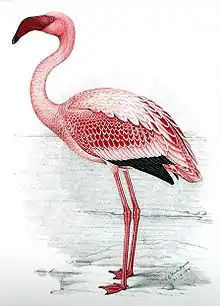Phoenicopterus
Phoenicopterus is a genus of birds in the flamingo family Phoenicopteridae.
| Phoenicopterus | |
|---|---|
 | |
| Greater flamingo (Phoenicopterus roseus) | |
| Scientific classification | |
| Domain: | Eukaryota |
| Kingdom: | Animalia |
| Phylum: | Chordata |
| Clade: | Dinosauria |
| Class: | Aves |
| Order: | Phoenicopteriformes |
| Family: | Phoenicopteridae |
| Genus: | Phoenicopterus Linnaeus, 1758 |
| Type species | |
| Phoenicopterus ruber Linnaeus, 1758 | |
| Species | |
Taxonomy
The genus Phoenicopterus was introduced in 1758 by the Swedish naturalist Carl Linnaeus in the tenth edition of his Systema Naturae to accommodate a single species, the American flamingo Phoenicopterus ruber.[1][2] The genus name is Latin for "flamingo".[3]
Species
The genus contains three extant species:[4]
| Image | Common Name | Scientific name | Distribution |
|---|---|---|---|
 |
Greater flamingo | Phoenicopterus roseus Pallas, 1811 | widespread in Africa and southwest, south-central Eurasia |
 |
American flamingo | Phoenicopterus ruber Linnaeus, 1758 | northern Galápagos Islands and the Caribbean |
 |
Chilean flamingo | Phoenicopterus chilensis Molina, 1782 | central Peru to Tierra del Fuego east to south Brazil, Uruguay and central Argentina |
References
- Linnaeus, Carl (1758). Systema Naturae per regna tria naturae, secundum classes, ordines, genera, species, cum characteribus, differentiis, synonymis, locis (in Latin). Vol. 1 (10th ed.). Holmiae (Stockholm): Laurentii Salvii. p. 139.
- Mayr, Ernst; Cottrell, G. William, eds. (1979). Check-List of Birds of the World. Vol. 1 (2nd ed.). Cambridge, Massachusetts: Museum of Comparative Zoology. p. 269.
- Jobling, James A. (2010). The Helm Dictionary of Scientific Bird Names. London: Christopher Helm. p. 304. ISBN 978-1-4081-2501-4.
- Gill, Frank; Donsker, David; Rasmussen, Pamela, eds. (July 2021). "Grebes, flamingos". IOC World Bird List Version 11.2. International Ornithologists' Union. Retrieved 19 August 2021.
This article is issued from Wikipedia. The text is licensed under Creative Commons - Attribution - Sharealike. Additional terms may apply for the media files.

